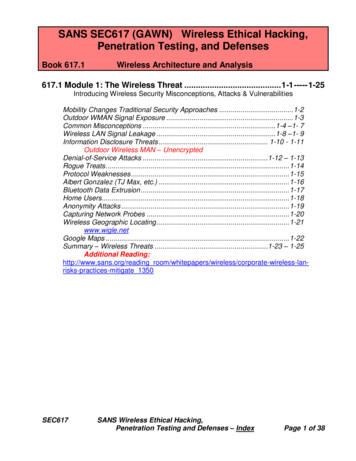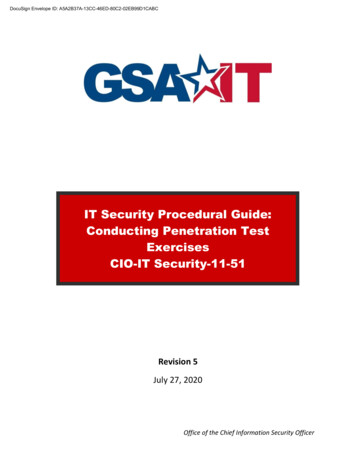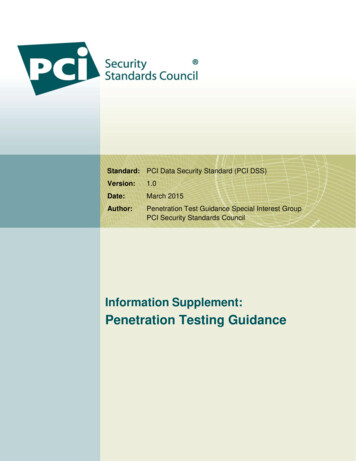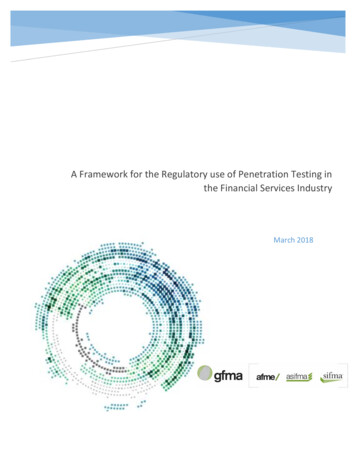
Transcription
HackingBeginner to Expert Guide to Computer Hacking, Basic Security, andPenetration TestingBy James Patterson
HackingBeginner to Expert Guide to Computer Hacking, Basic Security, andPenetration TestingBy James Patterson
IntroductionI want to thank you and congratulate you for downloading the book, “Hacking: Beginner's Guide toComputer Hacking, Basic Security, and Penetration Testing. ”This book will teach you how you can protect yourself from most common hacking attacks -- by knowinghow hacking actually works! After all, in order to prevent your system from being compromised, you needto stay a step ahead of any criminal hacker. You can do that by learning how to hack and how to do acounter-hack.Within this book are techniques and tools that are used by both criminal and ethical hackers – all the thingsthat you will find here will show you how information security can be compromised and how you canidentify an attack in a system that you are trying to protect. At the same time, you will also learn how youcan minimize any damage in your system or stop an ongoing attack.Thanks again for downloading this book. I hope you enjoy it!
Table of ContentsIntroductionTable of ContentsChapter 1: Hacking 101Who Hacks?Is Hacking for Everyone?What You Will Get HereIs It Difficult to Learn and Understand?Skills That You Need to HaveChapter 2: How Hackers Find Their TargetsThings That Hackers Search ForEstablishing a Hacking PlanSetting GoalsChapter 3: Mapping Out Your HacksOrganizing Your ProjectWhen Should You Start Hacking?What Do Others See?Mapping the NetworkDoing System ScansA Look at System VulnerabilitiesChapter 4: About AttacksWhat is a Passive Attack?What is an Active Attack?Chapter 5: Hacking ToolsChapter 6: How to Fool TargetsSpoofingMan-in-the-Middle AttacksChapter 7: Hacking PasswordsHow to Crack PasswordsNotes on Password EncryptionOther Ways to Uncover PasswordsChapter 8: Hacking Network ConnectionsHacking a WEP ConnectionThe Evil Twin Hack
Chapter 9: Introduction to Mobile HackingHacking Mobile AppsExploiting a Mobile Device RemotelyChapter 10: Social EngineeringSocial Engineering as Art and ScienceHow Social Engineering HappensTypes of Social Engineering AttacksWhat You Can Do Against Social EngineeringChapter 11: Physical AttacksWhy Physical Attacks WorkDiscovering VulnerabilitiesSecuring the PeripheryConclusion
ChapterChapter 1:1 : Hacking 101Whenever you encounter the word hacking, you probably associate it with sending an encrypted programto another user, and then being able to get unauthorized access on a remote computer.However, the term hacking was used to define any act of tinkering a computer’s hardware or softwareother than its intended use, in order to improve it and find out how electronic devices can workelectronically.While that definition technically still holds true, hacking has definitely made a whole new turn especiallywhen it comes to how another person can access someone else’s computer. Before you think that hackingis all about getting past securities to wreak havoc on somebody else’s digital device, you might need toknow the typestypes of hackers that exist nowadays.
Who Hacks?Hackers are typically divided into the following categories:1. Black hat hackersAlso known as criminal hackers or crackers, these people are those that maliciously gain access to anotherperson’s system for selfish gain. They typically hack electronic devices and modify, steal, or delete criticalfiles for their personal gain.2. White hat hackersWhite hat hackers, or ethical hackers, discover ways on how a device’s system can be exploited in order tolearn how people can defend themselves against possible attacks. These ethical hackers also make it apoint that the security services they issue are updated. They do this by being on the lookout and activelydigging for the newest exploits and new system vulnerabilities.Ethical hackers also make it a point that they discover new ways to learn how an electronic device can betinkered with to maximize its efficiency. For this reason, they build communities that allow them to crowdsource their knowledge in order to improve the way people use their devices.3. Grey hat hackersAs the name suggests, they are driven by white and black hat hacking motivations – they are the ones whoemploy both illegal and legal techniques to exploit or improve a system. However, if a grey hat hackerexploits another person’s system, he typically makes it a point to inform the owner of the exploits madeand then offers suggestions on what can be done to buff up system security.Once you are able to identify the hackers that you are likely to encounter, you will be able to know themotivation that they have for hacking and the types of hacks that they are likely to come up with.
Is Hacking for Everyone?While hacking is typically attributed to people who know how to code, everyone can learn how to hack. Atthe same time, it is also best to keep in mind that there is no one way of learning how to hack – hacks toimprove or attack systems are created through continuous evolution of a user’s knowledge on how asystem should perform. As you read this, you can count on that possibility that a new way to protect orattack a device or a network has already been created.If you have a computer or a mobile phone, then you are the best candidate for being a hacker. You havethe right motivation to learn how to tinker with a system and improve the way you use it. Since youconnect with other users out there through downloads, messages, online purchases, or uploads, you needto pay extra attention to how you can secure your own system. To do this, you need to learn how a blackhat hacker thinks, starting from the motivation that they have in attacking a system, to the rudiments of anattack. From that point, you will understand that you have plenty of preventive measures when it comes tostopping an unauthorized intrusion and even launch a counter attack.
What You Will Get HereThis book will tell you about the strategies commonly used by black hat hackers, which will enable you totest your own system’s vulnerabilities and how you can fall into different traps that are laid out for mostusers out there. Here, you will learn how people become candidates to become potential victims ofcriminal hackers and how you can protect yourself from such attacks. At this point, you get the idea – youare on your way to become an ethical hacker.Since your main concern is your own security and making it a point that you understand why attacks gothrough different systems, you will also need to learn how attacks are performed in the first place. You willbe able to figure out how criminal hackers penetrate devices by learning tools, techniques, and attacks thatthey use in their trade.Once you understand how an electronic device can be compromised, you will have a better idea on whatyou can do to prevent that from happening.
Is It Difficult to Learn and Understand?While hacking requires a lot of practice, it is not a difficult trade to be in. As long as you know how to use acomputer and you can follow instructions that you will find in this book, you can test or even performhacks that you will read in the later chapters.If you do not know how to code yet, no worries – you will find detailed instructions on what codingsoftware, operating system, and others later on. However, if you want to excel in hacking and you want todevelop your own security measures or test a version of an attack, then having coding skills is a must.
Skills That You Need to HaveTo become a good ethical hacker, you need to have the following skills:1. Intermediate computer skillsThis means that you need to have skills that go beyond creating a Word document or being able to surf theweb. To be a hacker, you need to know how to use different Windows command lines, set up a network, oredit your computer’s registry.2. Good networking skillsSince many, if not most, of hacker attacks are done online, you need to master networking concepts andterms, such as:WEP versus WPS passwordsNATMAC te and public IPsIPv4OSI modellingPacketsTCP/IP3. Using a Linux operating systemAlmost all hackers will have to use the Linux OS because it allows programs and tweaks that are notpossible in Windows and Mac operating systems. Almost all hacking tools that you can find also make useof this operating system.4. Virtualization
Before you even try testing an attack on a live system, you need to make sure that you know what you aredoing. To make sure that you are doing things right, you might want to try out a hack first on avirtualization software package, such as the VMWare Workstation. Using virtual workstations will provideyou a safe environment for your hack tests and prevent you from unintentionally causing damage to yourown device.5. Tcpdump or WiresharkThe tcpdump is known as a command line protocol analyser or a sniffer, while Wireshark is known as themost popular tool available that does the same function.6. Knowledge of Security Technologies and ConceptsAny hacker should be able to understand the most important concepts and technologies related toinformation technology. For this reason, you need to be familiar with wireless technology and concepts,such as Secure Sockets Layer (SSL), firewalls, Intrusion Detection System (IDS), Public Key Infrastructure(PKI), and so on.7. Scripting SkillsHaving the ability to create and edit scripts allows you to create your own tools and manage to beindependent from the tools developed by other hackers. By being able to build your own tools, you enableyourself to develop better defenses as criminal hackers create better hacks. To do this, you need tobecome a pro at using at least one of the commonly used scripting languages, such as Ruby on Rails orPython.8. Database SkillsIf you want to understand how hackers infiltrate your system’s databases, you need to see to it that youknow how databases work. This means that you need to master a database management system such asOracle or MySQL.9. Reverse EngineeringReverse engineering enables you to convert a piece of malware or similar exploit into a more advancedhacking tool. With this skill comes the understanding that almost all exploits done by hackers come fromother existing exploits – once you understand how a malware or exploit feature works, you will have abetter understanding of how other hacks work against a system.10. CryptographyCryptography, as a skill, enables you to understand how hackers conceal activities and cover their trackswhile performing hacks. It also helps you understand the strengths and weaknesses of different algorithmsused to decrypt personal information, such as stored passwords.
Chapter 2: How Hackers Find Their TargetsCriminal hackers are probably among the most strategic researchers that you will encounter in the techworld. In order for a hacker to obtain as much valuable data as they can in a single attack launch, they waitfor the perfect victim to show up in their sweep, study their prey, and then devise the best attack that theycan muster from their skill set.A black hat attack can target a single person or several people at a time, but most of the time, a hackeroperates on a particular niche. There are hackers that would want to find vulnerabilities in banking systemsonline because it will provide them access to millions of deposits that they can leech through their systems.Some value personal information and proceed doing personal attacks. Some prefer to deface landing pagesand broadcast their ability to get through a website’s security. Some choose to hack accounts so that theycan stay anonymous and make use of services without paying a cent.Whatever the criminal hacker’s motivation is in hacking a particular system, they will only proceed with anattack if they find that it can be done and that they can gain something out of it. With this said, the bestway to prevent a hack attack is to keep valuable information from the public as much as possible. Whilesharing information is almost deemed a necessity nowadays, you need to make sure that you are sharingdata only to legitimate users.
Things That Hackers Search ForFor a moment, step inside the mind of a criminal hacker. If you want to steal information or compromise asystem, you know that you can get value out of the following:1. Organization design, filings and registrationsMalicious hackers typically perform an online search to look for possible targets, and among the bestcandidates for an attack are those organizations that provide detailed descriptions of devices that theyhave access to, including the type of software and hardware that they have installed. Once hackers knowthat a certain person holds access to a possibly vulnerable point in an organization’s tech security, they getan idea on who they should hack first.Any hacker can obtain this extremely useful information with a simple online search. By digging online, youcan find all SEC registrations, public biddings, publicly accessed files, subscribers, and many more. You caneven search for all people involved in a particular organization, the time that a website is published, and thewebmaster involved in creating web security for an organization. Having that knowledge can easily help ahacker prepare for a massive online attack that can take down an entire organization’s website anddatabase.2. Subscriptions and paymentsHackers are most likely to hack devices and accounts owned by a person that make online payments orpurchases. Since smartphones, emails and online payment systems contain a wealth of personalinformation, including credit cards and banking statements, hacking these systems make it easy for everycriminal hacker to achieve identity theft.3. Social media accountsWhile some may say that there is possibly nothing valuable in a personal Facebook account, being able togain access to social media accounts also enables a hacker to gain access to other personal details, such aspasswords, emails, and mobile phone numbers.4. EmailsEmails serve as the hub of your personal information because it serves as a control point for all yourpasswords, online payment accounts, among others.5. PasswordsMany hackers perform an attack that is made to predict, snoop, or phish for a user’s password. Once they
are able to find a single password, they are almost certain that a user may use them for different accountsor use a variation of it for other logins.6. Physical hardwareIt is easiest to steal information when you have physical access to a device such as a smartphone or apersonal computer. You can easily check all accessed accounts through the registry, browser history, orsaved passwords without even having to use a code. At the same time, having physical access to a devicealso enables you to make it possible to plant a listening device into its system in order to phish out anyadditional information at any point in the future.7. Target locationsIf a hacker cannot find any vulnerability yet in a system that he wants to hack, the next thing that he will tryto find is where a computer system is. This will allow him to further study vulnerabilities through socialengineering, dumpster diving, or even gaining physical access to a targeted device.Since all computers have a MAC address, and every device connected through the internet has an IPaddress, every device in the world can be easily searched for in order to figure out where it is located. Ahacker, on the other hand, knows how to hide his location in order to remain undetected while he launchesan attack.
Establishing a Hacking PlanWhen you want to protect your own system, you need to know where you can be attacked by a hacker.That means that in order to catch a thief, you need to think like one.Now that you have an idea on what a hacker may be looking for whenever he does a sweep, you knowwhere to start creating your security points and where you should test out vulnerabilities.At this point, you get an idea on why a particular hacker may pinpoint a particular organization, individual,or a lone device as a target. Any smart hacker would target the following vulnerabilities:1. A user or caretaker that would possibly leave the targeted device unattended2. Weak or unchanged passwords that are possibly used across all synced devices3. Device owners that are unaware of the complexity of their own system, or is not up-to-date withsecurity protocolsWhen you think about how computers and internet connectivity are managed, you get the idea thatmajority of the systems that you use on a daily basis are not as secured as you want them to be. Hackersknow this, and for that reason, they can be certain that there are certain connectivity points that are notmonitored at all or that there are certain points in a firewall that can be easily become breached withoutbeing detected. It is also easy for every hacker to exploit an environment that they want to attack,especially when they know that they can gain full access without alerting administrators.Once vulnerability is discovered by a criminal hacker, you cannot expect a hacker to keep it to himself. Allhackers are capable of networking themselves to broadcast their activities and gain support from otherswithin the community. Because most system administrators and ordinary IT teams do not realize when anattack is about to happen or what their system’s vulnerability really is, criminal hackers have the leeway tobuy time to study what the most useful attack will be. Since criminal attackers plant their attacks, movevery slowly to avoid detection, and launch during the most vulnerable time, you also need to create aworking ethical hacking plan to prevent any attack.
Setting GoalsYou need to establish your own hacking goals by discovering your own system’s vulnerabilities in order toestablish enough security to protect them from attacks. Since you are going against a very sneaky enemy,you need to establish very specific goals and schedules on when you can start hacking your own system.Important Note: Keep in mind that before you create a plan, you need to make sure that you have all thecredentials for testing systems. Also see to it that you document ethical hack and system that you testedon, and provide a copy of documentation to the management. This will make sure that you have theprotection that you need just in any case you discover that a system is compromised or when somethingunexpected happens in your investigation.If you are testing your own system, documenting everything, including all the software peripheries that youhave tested and the type of tests you performed, is a must. This will ensure that you have followed all thesteps correctly, and if you need to retrace your steps, you have an idea on where you should get back to.Once you are able to follow every security protocol necessary, ask yourself the following questions:1. What kind of information in your system should you protect the most?You need to determine that what part of your system is the most vital to you. If you are holding a databaseof personal information or a file of an important project that many would like to get their hands on, then itmakes sense that you protect those files first.2. What’s your budget for ethical hacking?While there are numerous free tools online that will allow you to perform tests and hacks, the amount oftime, money, and effort that you can spend on your hacks will determine what kinds of tools you can useto safeguard your systems and research potential vulnerabilities. With this in mind, you get the idea that ifyou value time and effort, you need to have the right budget to purchase top-of-the-line ethical hackertools.3. What do you want to get out of your hacking tests?If you are hired as an ethical hacker by an organization, you need to determine what kind of justificationyou should present the management in order to achieve the best possible results out of your research.
Chapter 3: Mapping Out Your HacksWhen you are looking for vulnerabilities, you do not need to check every security protocol that you haveinstalled on all your devices at the same time – doing so will not only be very confusing, but may also causesome problems since you’ll have too much on your plate. Whenever possible, make it possible that youmake your testing manageable by breaking the testing project into more actionable steps.To make it easier for you to decide which systems should go first, ask yourself the following questions:1. Which systems, when attacked, would cause the most trouble or create the most problematic losses?2. Which parts of your systems look most vulnerable to a hacker attack?3. Which parts of your systems are least documented, rarely checked, or you barely know anything about?Once you are done creating your goals and you identified the most vulnerable parts of your systems, youcan now decide which ones you should test first. By knowing the results that you want to get and makingan actionable plan, you can set your expectations properly and have a good estimate on how long youshould be performing tests and how much resources you should spend on every test you perform.
Organizing Your ProjectThese should be the systems, applications, and devices that you should be performing your tests on:1. Email, print, and file servers2. Firewalls3. Database, web, and application servers4. Client/server operating systems5. Tablets, laptops, and workstations6. Switches and RoutersNow, the amount of tests that you can do will depend on how many devices and systems you need toperform your tests on. If you have a small network, then you can test every periphery. However, the entirehacking process can be flexible and should depend on what makes the most sense for you.If you are having trouble on which periphery or system you should start testing first, consider these factors:1. Type of operating system or applications runs on your system2. Classification and amount of critical information stored in your computer system3. Systems and applications that are located in the network.
When Should You Start Hacking?Every hack is made successful based on the timing that you chose to launch a test attack. When you aremapping out the schedule for your tests, make sure that you perform your tests on times that would causethe least possible disruption to other users. You do not want to cause trouble when testing a Denial ofService (DoS) attack during a critical business time when sales typically come in for the organization thatyou are working for. You also do not want to encounter system problems and being not able to resolve itjust in time before you need to use your own computer.When scheduling tests, make sure that everybody involved is on board with your plan. This will help you setexpectations and also give you a timeline on when you should be done testing.
What Do Others See?You can get a better perspective on the vulnerability of the systems that you need to test by first looking atwhat potential criminal hackers may be seeing from the outside. To do this, you need to see what kind oftrails your system leaves out there whenever someone uses your network.You can do the following to gather those footprints:1. Run an online search about the organization that you are working for. If you are performing tests foryour personal system, search for items related to you.2. Do a probe on possible open ports or run a complete network scan to determine specific system reportsthat outsiders may be seeing about your devices. Since you own the system you are about to test, you canuse local port scanners and share-finder tools available on Windows, such as LANguard or GFI.After that, you can perform more specific searches online. Try to find the following:1. Patents or trademarks2. SEC documents3. Acquisitions and previous mergers4. Press releases about the most vital procurements and changes in your organization5. Contact details that point towards members of the organization or employees. You can instantlydo background checks on the following sites:1. USSeach2. ChoicePoint3. ZabaSearch6. Incorporation filings. You can search for these usingwww.sec.gov/edgar.shtml (shows filings of public companies)businesssitessuchasHere’s a tip: if you can’t find the information that you are looking for or if you want to dig deeper on awebsite with a simple keyword search, perform an advanced web search. For example, if you want to findfiles on a particular website, you can use this stringssite: www.(domain).com (keyword or file name) – to search for specific files on a particularwebsitefiletype :swf (company) (name) – to search for Flash files that can possibly be decompiled to gainaccess to encrypted information
Now that you have an idea about what others see about what you are trying to protect online, it’s time foryou to start mapping the network and look for your system’s potential vulnerabilities.
Mapping the NetworkWhen you want to make a solid plan on how you are going to layout your ethical hacking plan, one of thefirst things that you need to know is how much other people know about your network. While you maythink that you have complete anonymity online, your computer continually leaves footprints that pointtowards you and the system that you are using.To get a better idea about how much information about you or your domain is available to the public, youmay want to take a look at the following:WhoisWhois is an online tool that you can use to see whether a domain name is available. However, it can alsobe used to see registration information about existing domains. That means that there is a big chance thatyour email addresses and contact information are being broadcasted online.Whois also provides information about DNS servers that are being used by your domain and details aboutyour service provider’s tech support. It also has a tool called the DNSstuff, which performs the following:Display which hosts handles that email for a particular domainDisplay locations of hostsSee whether a particular host is blacklisted as a span hostShow general information about a domain’s registration.Apart from the Whois, you can get similar information about different domains by using the following:1. www.dot.gov – provides information about the government2. www.nic.mil – provides information about the military3. www.afrinic.net – provides information from an Internet Registry in Africa.4. www.apnic.net – provides information on Asia Pacific Regional Internet Registry.5. ws.arin.net/whois/index.html – provides information about the Internet Registry on some parts ofsubequatorial Africa, North America, and some areas in the Carribean.6. www.lacnic.net/en - provides information about Carribean and Latin American internet registries7. www.db.ripe.net/whois - provides information about internet registry in African, European, Middle East,and Central Asian regions.Forums and Google GroupsForums and Google groups provide a wealth of information about public network information, such as IPaddresses, usernames, and lists of full qualified domain names (FQDNS). You can search for tons of Usenetposts and find private information that you may not realize has been posted in public, which may includehighly confidential information that may reveal too much about your system activities.
Here’s a tip: if you are aware that you have confidential information posted online, you may be able to getit out of the internet so long as you have the right credentials. All you need to do is to reach out to thesupport personnel of the forum of the Google group or forum that posted the private information and filea report.Privacy PoliciesA website’s privacy policy is a way to let people who are using the site become aware of the types ofinformation that are being collected from them and how information is protected whenever they visit thesite. However, a privacy policy should not divulge any other information that may provide hackers ideas onhow they can infiltrate a system.If you are starting to build your website or trying to hire someone to write your privacy policy, see to it thatyou do not broadcast the infrastructure of your network security. Any information about your firewall andother security protocols will give clues to criminal hackers on how they can breach your system.
Doing System ScansOnce you know how you can actively gather information about your network, you will have an idea on howcriminal hackers would possibly launch an attack against your network. Here are some of the things thatyou can do to see how vulnerable your system is:1. Use the data you found on your Whois searches to see how related hostnames and IP addresses can belaid out. For example, you can verify information on how some internal hostnames, operating protocols,running services, open ports, and applications are displayed on a web search, which may give you an ideaon how criminal hackers may soon infiltrate your system.2. Scan your internal hosts and know what possibly rogue users may access. Keep in mind that an attackermay come from within your organization and set up shop in one of your hosts, which can be very difficultto point out.3. Check your system’s ping utility, or use a third-party utility that enables you to ping different addressessimultaneously. You can do this by using tools such as NetScan Tools, fping (if you are using Unix), orSuperScan. If you are not aware of what your gateway IP address is, you can search for your public IPaddress by going to www.whatismyip.com.4. Do an outside-in scan of your system by scanning for open ports. To do that, you can use tools such asNmap or Superscan, and then check what others can see on your network traffic by using tools such asWireshark or Omnipeek.By doing this scan, you can get an idea on what other peopl
I want to thank you and congratulate you for downloading the book,“Hacking: Beginner's Guide to Computer Hacking, Basic Security, and Penetration Testing.” This book will teach you how you can protect yourself










